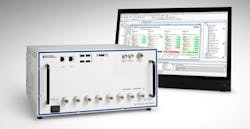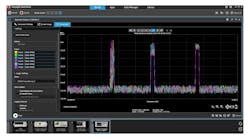Flexible tools address changing IoT test needs
From development tools and simulation environments to programs that can speed manufacturing test, help visualize measurement results from multiple instruments, and support troubleshooting, software plays a key role in test-and-measurement projects, including those related to connected devices and smart objects.
Jay Torgerson, business development manager for the Internet of Things at Anritsu, elaborated on that point, saying, “Many connected device product designers may not have wireless technology experience and therefore will rely on intelligent, easy-to-use test equipment to meet their broad and changing testing needs. Features such as simple test setup wizards, autoranging parameters, and good technical support allow developers to be operational quickly. Additionally, testing must be meaningful, fast, and repeatable. Unattended, automated testing allows engineers to conduct repeatable tests while they perform other product development tasks that can help bring products to market faster.”
Development through manufacturing
National Instruments offers software tools covering the gamut from development through manufacturing test. David Hall, principal product manager for RF test systems at NI, said, “Although NI’s core measurement software for wireless test is consistent across the product life cycle and value chain, the way that customers interact with the software often varies from one application to the next. The majority of NI customers interact with the measurement hardware through a combination of NI LabVIEW and NI TestStand (Figure 1) software.
Courtesy of National Instruments
“For semiconductor production test and wireless production test applications, NI offers specialized plug-ins for TestStand that simplify software development,” he said. “For semiconductor test, the NI TestStand Semiconductor Module provides advanced DUT-centric software features such as binning, SFDF data reporting, and pin-to-channel mapping,” he added.
National Instruments also addresses wireless production test applications, for which, Hall said, “The NI TestStand Wireless Test Module (WTM) provides additional DUT-centric software features such as prescripted test sequences and code modules for DUT control. Using WTM, test engineers can quickly and easily create a customizable test sequence that is inherently designed for parallel test.”
Martha Zemede, 5G and IoT outbound marketing lead for the Wireless Cross-Divisional Initiative at Keysight Technologies, cited some of the company’s wide range of software tools for use with Keysight instruments. “In order to streamline compliance testing, our solutions support Signal Studio’s flexible suite of signal-creation tools and proven X-Series one-button applications,” she said. “For troubleshooting designs, the detailed 89600 VSA is available.”
She added, “For automated testing, we offer a number of software tools to do chipset control. In addition, our Application Engineering Organization (AEO) experts help customers to integrate their tools or AEO-based tools to bring a test system up and get it running quickly.”
Keysight recently introduced the M9420A VXT PXIe vector transceiver, which targets connected-device test from product development to design validation to manufacturing. “The VXT offers multiple drivers including IVI-COM, IVI-C, LabVIEW, and [MathWorks] MATLAB and can be programmed in a variety of development environments,” Zemede said. “This includes Visual Studio (VB.NET, C#, C/C++), VEE, LabVIEW, LabWindows/CVI, and MATLAB. Sample programs make it easy to get started. Additionally, customers can access a user interface, also SCPI programmable, which is based on the familiar interface seen on the Keysight benchtop X-Series signal analyzers.”
HLL and simulation environment
For its part, in September MathWorks introduced Release 2015b (R2015b) of both MATLAB, the high-level language and interactive environment that supports industries ranging from transportation to communications, and Simulink, a block-diagram environment for multidomain simulation and model-based design.
MATLAB updates include a new execution engine that runs MATLAB code faster as well as graph and directed-graph functions for creating, analyzing, and visualizing graphs and networks. The new version also includes Add-On Explorer—a single interface for adding community-authored and MathWorks toolboxes, apps, functions, models, and hardware support—as well as MATLAB Compiler SDK, which consists of deployable MATLAB components for integration with applications written in Python. New toolboxes include the Statistics and Machine Learning Toolbox, the Parallel Computing Toolbox, the Image Processing Toolbox, the Computer Vision System Toolbox, the Database Toolbox, the Control System Toolbox, and the Robust Control Toolbox.
Simulink updates feature a new UI for viewing and debugging signals with cursors and measurements, referenced projects for creating reusable components and simplifying large modeling projects, always-on tuning of block parameters and workspace variables during simulation, and multilingual block names, signal names, and MATLAB function comments for use across Simulink as well as the Stateflow and Simulink Coder tools.
Signal processing and communications features in the new release include the Antenna Toolbox (for analysis of infinite arrays and visualization of E-H fields) and the LTE System Toolbox (supporting Release 12 downlink 256 QAM modulation for small cells, Release 11 multicell zero power CSI-RS patterns, and enhanced waveform generation).
Wireless communications protocols
Ak Emarievbe, product marketing manager at Rohde & Schwarz, said his company offers a variety of software tools for developing and testing communications protocols for wireless devices, including ones for use with the R&S CMW500 protocol tester, which offers a development environment for layer 1 to layer 3 signaling scenarios with automatic configuration of the layers below. “The message analyzer tool is designed for automating and analyzing signaling scenarios for all layers and all applications,” he said. “For protocol conformance requirements, the TTCN-2/-3 libraries and software tools are available for developing signaling conformance test cases. Wireless signaling tests can be created simply with an easy-to-use graphical test script tool. To speed up test development, an extensive library with preconfigured messages and signaling also is provided.”
He also cited the R&S CMWrun sequencer software tool, which he described as a ready-to-use solution for configuring test sequences by remote control. “It can be enhanced with options and used for all standards for general RF testing, preconformance, and superior user experience test scenarios,” he said. “This automation software meets all requirements for executing remote-control test sequences in R&D, quality assurance, production, and service for both current and future wireless equipment. The architecture allows easy and straightforward configuration of test sequences without requiring specific programming knowledge of how to remotely control the instrument. It also has full flexibility when configuring parameters, and limits for the test items are provided. The intuitive graphical user interface makes it simple for users to test DUTs for compliance with the 3GPP protocols for various technologies. At the end of the test, an easy-to-read test report containing limits, test results, and the verdict is generated.”
Emarievbe also commented on R&S CMWcards, a graphical test-script-definition tool used to prepare the tests users have always wanted to perform but never found the time to set up. With CMWCards, he said, users can “… create wireless signaling and application tests just by setting up a hand of cards—no programming required. Revolutionary card wizards and unique game rules guide users through setting up test sequences that fully comply with test specifications. R&S CMWcards can be utilized to rapidly reproduce signaling scenarios for various wireless communications standards.”
Finally, he cited R&S CMWmars—a message analyzer for signaling applications. “Users can efficiently analyze recorded-message log files or trace information on the fly in real time while a test is running. The convenient, intuitive user interface combined with various tools and views help users quickly narrow down the root cause of signaling protocol and lower-layer problems,” he said. “The multifunctional log file analyzer provides access to all information elements of all protocol layers for LTE, WCDMA, GSM, TD-SCDMA, CDMA2000, WLAN, and Bluetooth, including the IP layer. It is a well-established analysis tool for customers such as chipset manufacturers, handset manufacturers, and mobile network operators as well as for device certification in test houses.”
Continuing evolution
Software tools for wireless and related test applications will continue to evolve. As this article went to press, Keysight announced the release of the latest version of its BenchVue software—the intuitive, easy-to-use PC application that provides multiple-instrument measurement visibility and data capture—that eliminates the need for instrument programming.
BenchVue 3.0 (Figure 2) introduces a new capability that allows for custom creation of simple automated tests. The new BenchVue Test Flow app features a drag-and-drop interface that allows for rapid prototyping of test sequences. The app combines a sequencer with data-capture and analysis tools, and the 3.0 release also features the addition of a Network Analyzer app along with additional model support. The total number of supported instruments is more than 300. BenchVue 3.0’s internal architecture allows for independent updates and downloads of individual applications. The company said that with BenchVue 3.0, downloads are smaller, updates are faster, and application software releases are no longer tied to BenchVue platform releases.
Courtesy of Keysight Technologies
For more information


